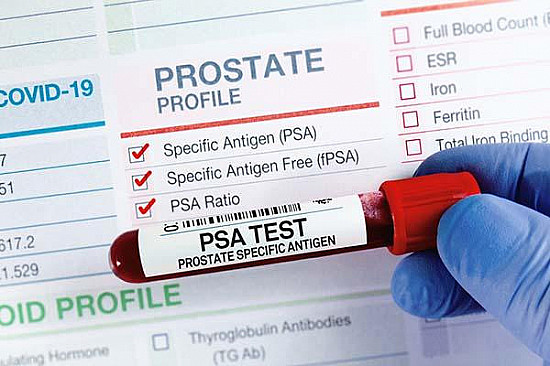New study supports lifesaving benefits from PSA screening
Charles Schmidt
Does screening for prostate cancer with the prostate-specific antigen (PSA) test save lives? A new study suggests that it does, but at the risk of exposing men with slow-growing tumors that may not be life-threatening to treatments they may not really need.
Published in Annals of Internal Medicine, the study reconciles conflicting results from the two largest clinical trials yet looking into whether PSA screening reduces prostate cancer death rates. One of them, the Prostate, Lung, Colorectal and Ovarian (PLCO) clinical trial divided 76,693 American men between the ages of 55 and 74 into two groups. Half the men got a PSA test every year for six years, while the other half — the control group — got their usual medical care, which may or may not have included screening. Results published in 2012 showed that more men from the screening group were diagnosed with prostate cancer after 13 years of follow-up. But prostate cancer death rates in the screening and the control groups were the same, indicating that PSA screening hadn’t saved any lives.
The other clinical trial, called the European Randomized Study of Screening for Prostate Cancer (ERSPC), enrolled 182,160 men, aged 50 to 74, from various European countries. Half of those men were offered PSA screening once every four years; the remaining men in the control group got usual medical care, which might have included screening. Results also published in 2012 showed that after about 11 years of follow-up, 299 men from the screening group had died of prostate cancer, compared to 462 men from the control group. Those data suggested that screening lowers the relative risk of prostate cancer death by 21%.
Researchers have been grappling with these conflicting results ever since, especially because the PLCO trial had a significant shortcoming. As was not the case in the ERSPC trial, large numbers of men in the PLCO control group had at one time or another been given a PSA test. The PLCO researchers should have been comparing prostate cancer death rates among men who had been screened or not screened for the disease. But the PLCO screening and control groups weren’t dissimilar enough in this respect that researchers could detect survival differences between them reliably.
A new approach
To address that problem, the research team combined and then reanalyzed data from both studies using different statistical methods that could limit the contaminating impact of PSA screening on the PLCO controls. And after this statistical adjustment, the researchers discovered that the final results from both trials were comparable: depending on the specific statistical analysis used, PSA screening was associated with a 25% to 32% lower relative risk of dying from prostate cancer.
Researchers have long agreed that the lifesaving benefits from PSA screening are small. The new study doesn’t change that overall perception, though it “does provide more evidence that screening can be beneficial,” said lead author Alex Tsodikov, a professor of biostatistics at the University of Michigan School of Public Health in Ann Arbor.
Still, the benefit should be interpreted in the proper context. Men in the United States have a roughly 3% risk of dying from prostate cancer over their lifetimes.
If PSA screening drops that risk by roughly a third, then the lifetime odds of dying from prostate cancer fall from 3% to just over 2%. Put another way, the new analysis shows that more than 1,000 men would have to be screened with a PSA test — and more than 35 treated — to prevent a single prostate cancer death.
In an accompanying editorial, Andrew Vickers, a biostatistician at the Memorial Sloan Kettering Cancer Center in New York, acknowledged that PSA screening “does good by saving lives, but also causes harms in terms of overdiagnosis and overtreatment.” Therefore, PSA screening should be deployed strategically to maximize benefits.
For instance, screening should be abandoned in men over the age of 70 who aren’t likely to benefit from it, and biopsies should be limited to men who screen positive and are also at high risk for aggressive, life-threatening prostate cancer according to new and emerging types of biomarkers, Vickers proposed. With these and other approaches, he claimed, overdiagnosis might be reduced by up to 70%.
Dr. Marc Garnick, the Gorman Brothers Professor of Medicine at Harvard Medical School and Beth Israel Deaconess Medical Center, and editor in chief of HarvardProstateKnowledge.org, cautioned that the lifesaving benefits of PSA screening remain uncertain, given underlying differences in how the PLCO and ERSPC studies were conducted.
Though statistical reanalysis can provide some additional clarity, “the new study does little to advance our understanding of the benefits versus harms from screening,” he said. “What we need, and what many investigators are working on, are ways to assign appropriate treatments based on a prostate tumor’s genetic makeup. Only then, in the context of prospective controlled studies, will we be able to place the utility of PSA-based screening in the proper context,” Dr. Garnick said.
About the Author

C.W. Schmidt, Editor, Harvard Medical School Annual Report on Prostate Diseases
Disclaimer:
As a service to our readers, Harvard Health Publishing provides access to our library of archived content. Please note the date of last review or update on all articles.
No content on this site, regardless of date, should ever be used as a substitute for direct medical advice from your doctor or other qualified clinician.















